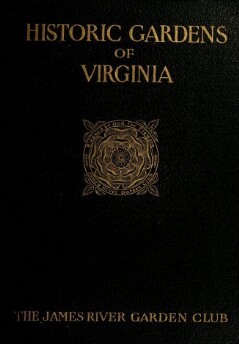

OCR
aa — ————————— —— ——I GY Mis ToR RC MGAR DEMS: OF 2 VIRGINIA — ae — — —_ —_ — = ne poppies, delphiniums and phlox. Digitalis grows around lilac clumps; these, with crepe myrtle and spiraea—with a cedar here, a euonymus there—appear to have been planted to point up the garden. While the box maze is by far the most interesting, it 1s by no means the whole garden. Beyond it, on the east, is a vegetable acre, separated by a line of forsythia suspensa and bridal wreath. A slight fall drops above this, bordered by a scattering line of briar roses, where the half acre allotted to iris begins and the boxbordered Ghost Walk ends. On the north of this lies the rest of the vegetable garden, bisected by iris-bound grass walks, beginning beneath the shade of peach trees, to end in the shadow of plums. Leaving the Ghost Walk at abrupt right angles, the path broadens to let the eye follow a second walk up to the old brickwalled burying-ground of the Randolphs. Opposite the graveyard, extending the entire length of the turfed walk, is the perennial border, where a chain of golden cowslips ushers in the spring. At the back of this flowery border, serving as a screen for the kitchen garden, are irregular lines of flowering almond, lilac, cydonia japonica, calycanthus, dogwood, forsythia, holly and Scotch broom. In line with the boxwood at the garden entrance stand peach trees. Scattered among these, above the honeysuckle hedge, the ailanthus, or Tree of Heaven, with its fern-like foliage, gives an effect of almost tropical luxuriance. One receives, upon entering this garden, and one carries away, an impression of sunshine, even on gloomy days. And down below, upon a terraced bit of wood-— land, montbretias or blackberry lilies grow naturalized. | From an old farm record we learn how the land at Tuckahoe was tilled, and the contents of the orchards. We read with interest that in 1850 it took between seven and eight hundred pounds of bacon and one hundred and fifty-six barrels of corn to begin to feed the plantation force each year. At that time the estate was the property of Joseph Allen, and he it was who kept the farm [120]
Strukturalno
Custom
Image Metadata
- Širina slike
- 9980 px
- Visina slike
- 14142 px
- Rezolucija slike
- 300 px/inch
- Veličina originalnog fajla
- 14.74 MB
- Permalink ka JPG-u
- knv_000013/0194.jpg
- Permalink ka OCR-u
- knv_000013/0194.ocr
